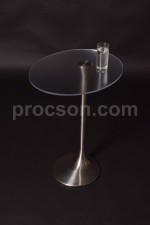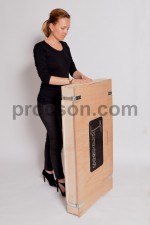About this new modern pulpit:
Our previous pulpit designs have geometric shapes. Made up of what are called primary forms. For example circles, cones, rectangles etc. These shapes look good, and are relatively easy to make.
The Arc3 pulpit is a radical departure.
It uses organic shapes (non primary shapes). This is much more modern. It creates a more flowing appearance and a more dynamic feeling. This reflects the dynamic nature of church preaching. The preacher will rarely stand still on the stage. Instead they are dynamic- moving around, gesturing and expressing.
Making organic shapes is much more difficult. It is even more difficult in stainless steel. We estimate that it is about eight times more difficult to make an Arc3 compared with an Arc2.
In fact the organic shapes we wanted to make had never been achieved in stainless steel.
For a while we explored other materials. That would have been much easier. But other materials are not as durable as stainless steel. We want the lectern to stand up to the strain of being used in a church for 20 years, and still look good. If we were to use a painted finish, a chip or scratch would need to be retouched. Stainless steel is raw- so a scratch or knock will not be noticed in the same way. Most marks can be removed by carefully rubbing with a heavy duty scotch brite pad from the supermarket (like you would use to clean pots).
In addition, stainless steel and clear acrylic (with anti reflective film) are what designers might call ‘raw finishes’ .
Unlike painted or applied finishes, raw finishes have a neutral appearance and are more likely to fit into a variety of church interiors. It can be a traditional cathedral, or a modern warehouse church building- raw finishes will still look good.
The Arc3 has a large 70cm (28”) wide top. Plenty of room for a large book of notes and a bible to sit side by side. If you need the top to be smaller, we can make a smaller 60cm/ 24” wide top (at extra cost- please e-mail us).
It comes flat (keeps the parts safer and avoids the cost of sending air). It requires assembly. We provide the tools and we expect it to take you less than 5 minutes.
Like our other lecterns, it is made by us here in Australia. It takes constant monitoring and problem solving to achieve our standards. We are pulpit specialists, so this is all we do. It takes commitment to this one thing to be able to make this difficult lectern at all, let alone to a high standard.
It is going to sit in the middle of your stage and your congregation are going to look at it every weekend. We need to be committed to do whatever it takes to get the best possible result. There is no way that this would be possible by sending it away to have someone else try to make it.
More about the painful birth of the Arc3
Although still modern, to us the Arc2 lectern was looking a bit long in the tooth.
We tried 17 times to design a better lectern than the Arc 2. 16 times our select customers said they preferred the Arc 2. It was fruitless and exhausting. Finally Stephen designed a lectern shape that was amazing looking but impossible to make. We spent thousands of dollars and many hours painstakingly hand making one. Our select customers loved it. They wanted to buy it. We had to find a way to make it at a reasonable price.
We spent 2 years trial and error working out how to make it. It was impossible to make using conventional machines, so we had to make our own machines. We made machines from a metal cutting flame throwing torch, windscreen wiper motors from tractors, and more conventional parts. In the process, we had 11 suppliers say that various parts were not possible to make, produced 436 design drawings, and we set fire to a tree.
THIS PRODUCT IS CURRENTLY OUT OF STOCK. Please email steve@procson.com for more details. 


